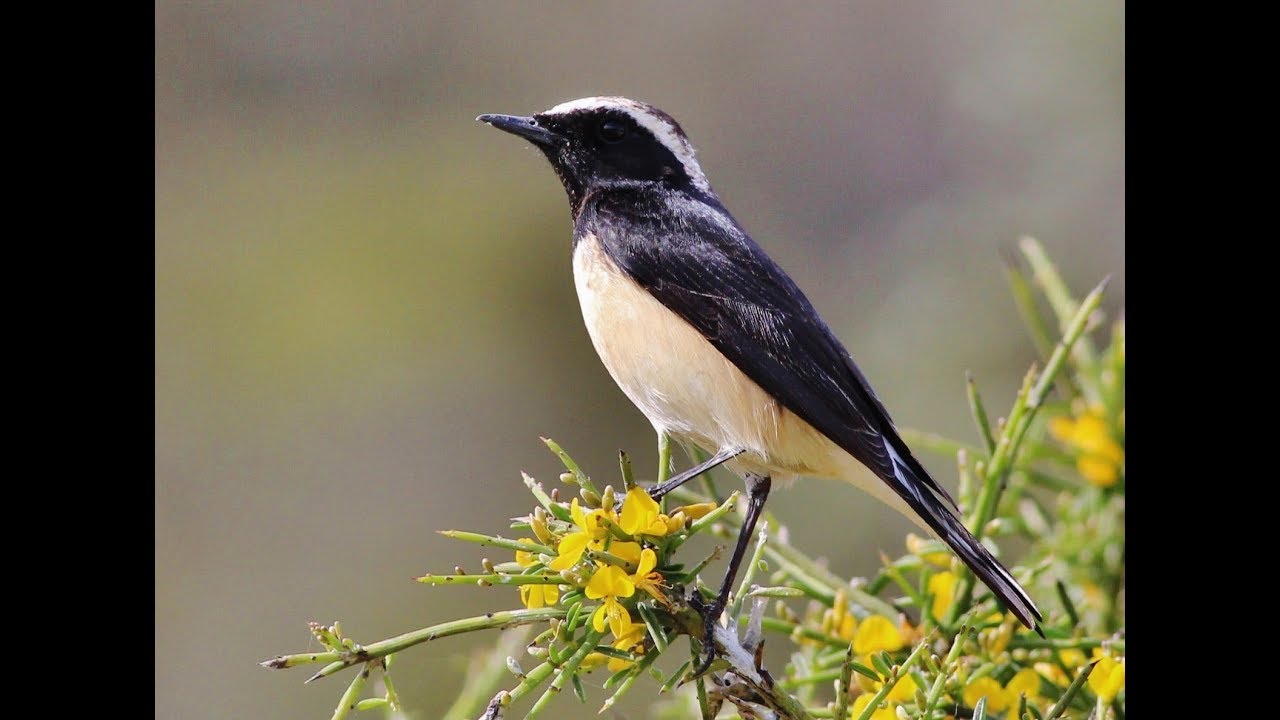Cyprus hosts three endemic species that breed nowhere else, the Cyprus Wheatear (Oenanthe cypriaca), Cyprus Warbler (Sylvia melanothorax) and the Cyprus Scops Owl (Otus Cyprius)
The Cyprus warbler (Sylvia melanothorax) is a typical warbler which breeds on Cyprus. This small passerine bird is a short-distance migrant, and winters in Israel, Jordan and Egypt.
Like most Sylvia species, it has distinct male and female plumages. The adult male is a small typical warbler with a grey back, black head, white malar streaks (“moustaches”), and, uniquely among typical warblers, underparts heavily streaked with black. The female is mainly grey above, with a greyer head, and whitish with only light spotting. The Cyprus warbler’s song is fast and rattling, and is similar to that of the Sardinian warbler.
Together with Rüppell’s warbler it forms a superspecies with dark throats, white malar streaks and light remiges fringes. This in turn is related to the species of Mediterranean and Middle East Sylvia warblers that have a naked eye-ring, namely the subalpine warbler,Sardinian warbler and Menetries’ warbler. Both groups have a white malar area, but this may not form a clear streak in the latter group; above the white, the heads of males are uniformly dark.(The Sylvia Monograph, A & C Black, London; Jønsson & Fjeldså 2006)
This is a bird of dry open country, often on hill slopes, with bushes for nesting. The nest is built in low shrub or gorse, and 3-5 eggs are laid. Like most “warblers”, it is insectivorous, but will also take berries.
From Wikipedia, the free encyclopedia
The Cyprus Scops Owl is a small owl that is unique to Cyprus. Until now, based on differences in its plumage and song, until recently, the Cyprus Scops Owl (Otus scops cyprius) was treated as a subspecies of the Eurasian Scops Owl (Otus scops scops), which is found in mainland Europe. The Cyprus sub-species was considered as distinct, but still likely to breed with the mainland Scops. Taxonomy, the science of classifying organisms into species, is continually evolving as new information is brought to light, and species are “lumped” (when two or more species are merged into one) and “split” (when one species is divided into two or more) accordingly by taxonomic authorities. In the case of the Cyprus Scops Owl, recent studies have shown that its song and plumage are sufficiently distinct from those of the mainland species to suggest that Cyprus birds most probably do not breed with Eurasian Scops Owls after all. In light of this, BirdLife International, the Red List Authority on birds and the world leader in bird conservation, has recognized the Cyprus Scops Owl as a full species, Otus cyprius. With the Cyprus Scops Owl’s global breeding range confined to Cyprus, this means that Cyprus has a new endemic bird species!
From https://birdlifecyprus.org/news-details/in-the-press/cyprus-scops-owl-is-100%-cypriot-and-proud?fbclid=IwAR27eRBJoBNAaL0B5Z2HNu5U3IVd1bJnrzu5Mia9ulEhku2uuyilwetbBuY
The Cyprus wheatear or Cyprus pied wheatear (Oenanthe cypriaca) is a small, 14–15 cm long passerine bird that was formerly classed as a member of the thrush family Turdidae, but is now more generally considered to be an Old World flycatcher, Muscicapidae. It was formerly treated as a subspecies (race) of pied wheatear but Sluys and van den Berg (1982) argued that the form deserved full species status, on the basis of differences in biometrics and especially song, and the lack of sexual plumage dimorphism in cypriaca.
This migratory insectivorous species breeds only in Cyprus, and winters in southern Sudan and Ethiopia. It has been recorded as a vagrant on Heligoland, Germany,
This species closely resembles pied wheatear, although it has slightly more black on the tail and back, and on the head. The sexes are similar in appearance, a fact first documented by Christensen (1974). A 2010 study found that Cyprus wheatear differs from pied wheatear in 14 external morphometric characters.
The song is distinctive, and very different from that of pied wheatear, resembling an insect. It consists of a series of high-pitched buzzing bursts.
The song-perches utilised by this species are high for a wheatear, typically being 5 to 10 metres above ground. It often breeds in woodland habitats, unlike other wheatears (Oliver 1990 suggested that it occupies the ecological niche used elsewhere in the Western Palearctic by the common redstart). It is the most arboreal species of wheatear in the western palearctic and it uses often aerial sallying and perch-pounce-feeding tactics. Recent work suggest an ecological differentiation between Cyprus wheatear and migrating northern wheatears O. oenanthe and black-eared wheatears O. hispanica melanoleuca. Cyprus wheatear uses more aerial sallying and occupies more forested habitats, but needs a minimum amount of open/bare ground, and a minimum of high bush/tree vegetation (Randler et al. 2009.
From Wikipedia, the free encyclopedia
source
The three endemic birds of Cyprus – Cyprus Warbler – Cyprus Wheatear – Cyprus Scops Owl
